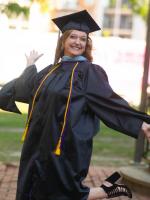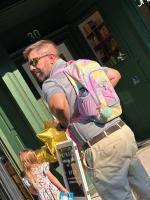Creating a Virtual Flight Plan: Get Started with VR in the Classroom
,
Colorado Convention Center, Bluebird Ballroom Lobby, Table 14
Presenters


Session description
Purpose & objective
The purpose of our presentation is to provide educators with the background on how to implement Virtual learning into their curriculum seamlessly. Participants will learn benefits of VR, types of VR, different platforms and apps, best practices, how to plan, best practice for use with students. The session is designed as an interactive choice within the poster. The poster will provide QR codes with links to samples of each of the areas described above. Teachers will learn models employed as best practice and use lesson plans provided by our presentation as a sample for implementation. We will use a visual slideshow to share a presentation, as well as evidence of success in our county with how we used it with our Summer Bridge program for PBL. The session will alow participants to ask and get the infromation from the areas they need and they will have the opportunity to demon the VR headsets. Additionally, resources will be provided to premade tours that are compatible with almost any VR headset. Handouts and resources will be provides for a take and learn model.
Outline
Our presentator is designed for an open poster session format. There will be QR codes for resources, samples of student work, samples of teacher templates, and a slideshow to share with those visiting the booth. Additionally, VR headsets would be provided to demonstrate the technology.
The interaction with the audience would include demonstrations, one one one discussions We will have interactive features so that those coming by can scan and download resources. Additionally, we will have a screencast recording of a full in depth presentation that is available within our resources that would be able to view anytime. Additionally, we will have door prizes for visitors, we will be giving away sample Instructables & Google Cardboards.
Supporting research
Southgate, Erica. (2020). Virtual Reality in Curriculum and Pedagogy: Evidence from Secondary Classrooms. 10.4324/9780429291982.
Anderson, A. (2019). Virtual Reality, Augmented Reality and Artificial Intelligence in Special Education: A Practical Guide to Supporting Students with Learning Differences (1st ed.). Routledge. https://doi.org/10.4324/9780429399503
Moran, Clarice & Rice, Mary & Whipple, Dawn & Khoshnevisan, Babak & Gallegos, Benjamin & Ralston, Nichole & Smith, Rebecca & Marlatt, Rick & Wright, William & Cloonan, Anne & Paatsch, Louise & Oughtred, Christine & Statti, Aubrey & Torres, Kelly & Athanases, Steven & Welsh, Megan & Higgs, Jennifer & Mawer, David & Kearney, Erin & Jacobson, Paige. (2021). Virtual and Augmented Reality in English Language Arts Education. COPY
https://www.ascd.org/el/articles/i-can-see-it-math-understanding-through-virtual-reality
https://www.ascd.org/el/articles/virtually-in-the-classroom
https://www.ascd.org/el/articles/new-realities
Session specifications
Designer
- Use technology to create, adapt and personalize learning experiences that foster independent learning and accommodate learner differences and needs.
- Design authentic learning activities that align with content area standards and use digital tools and resources to maximize active, deep learning.
- Explore and apply instructional design principles to create innovative digital learning environments that engage and support learning.
 Return
Return Participate and share: Poster
Participate and share: Poster  Trips and Tours
Trips and Tours